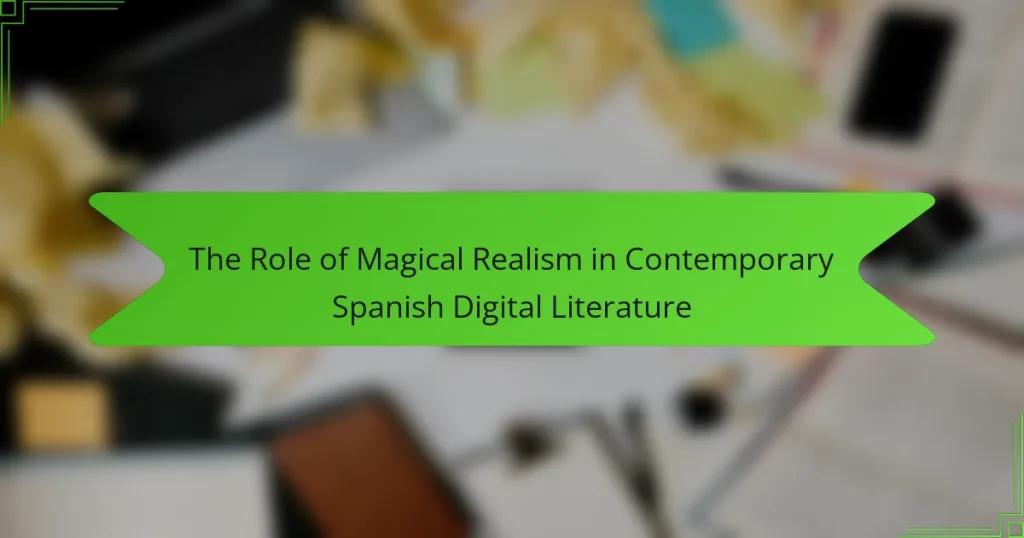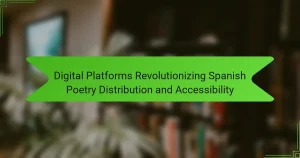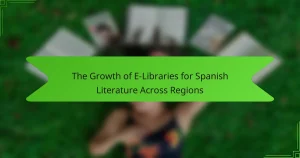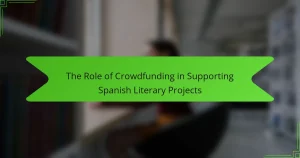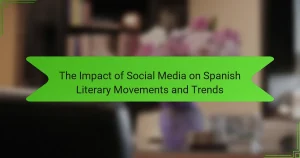Magical realism plays a crucial role in contemporary Spanish digital literature by blending the ordinary with the extraordinary. This genre allows for the exploration of themes like identity and cultural memory, while interactive storytelling enhances reader engagement. Additionally, it serves as a medium for social critique, reflecting societal issues through fantastical elements. The unique narrative techniques employed in this genre contribute to a rich and immersive reading experience.
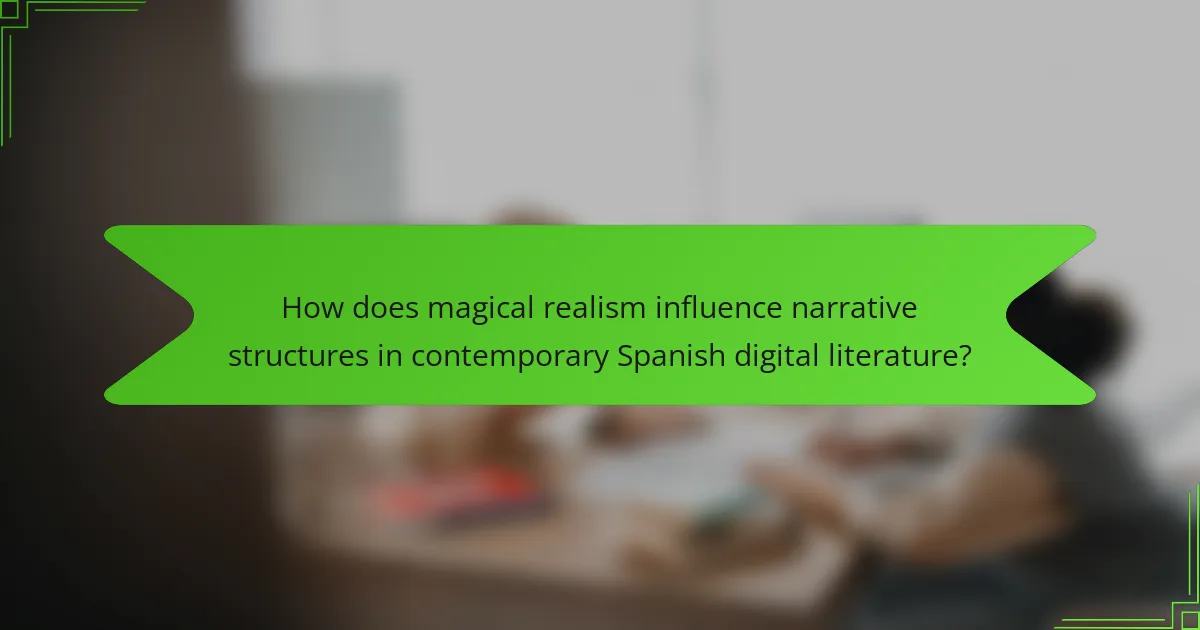
How does magical realism influence narrative structures in contemporary Spanish digital literature?
Magical realism significantly shapes narrative structures in contemporary Spanish digital literature by blending the ordinary with the extraordinary. This genre allows authors to explore complex themes, such as identity and cultural memory, through surreal elements that challenge reality.
For instance, digital platforms facilitate interactive storytelling, enabling readers to engage with magical elements in unique ways. This interactivity enhances the narrative experience, allowing for multiple interpretations and deeper emotional connections.
Moreover, the incorporation of magical realism often reflects societal issues, providing commentary on political and social landscapes. By weaving fantastical elements into digital narratives, authors can critique reality while inviting readers to envision alternate possibilities.
In summary, magical realism enriches contemporary Spanish digital literature by fostering innovative narrative techniques and encouraging critical engagement with real-world themes.
What are the key characteristics of magical realism in this context?
Magical realism in contemporary Spanish digital literature blends the ordinary with the extraordinary, creating a unique narrative style. Key characteristics include the integration of fantastical elements into realistic settings, which challenges readers’ perceptions of reality. This genre often features a strong cultural context, reflecting social and political issues through its magical elements. Additionally, it employs a non-linear narrative structure, allowing for multiple interpretations and deeper engagement with the text. The use of vivid imagery and sensory details enhances the immersive experience, drawing readers into the magical world.
How do digital platforms enhance the expression of magical realism?
Digital platforms significantly enhance the expression of magical realism by providing immersive and interactive experiences. These platforms allow authors to blend traditional narrative techniques with multimedia elements, creating layered storytelling.
For instance, interactive websites enable readers to engage with visual art, soundscapes, and animations that complement the text. This integration deepens emotional connections and enhances the surreal qualities typical of magical realism.
Moreover, social media facilitates real-time reader-author interactions, fostering community discussions around themes and interpretations, which enriches the narrative experience. Digital formats also allow for innovative storytelling methods, such as hypertext fiction, where readers choose their paths through the narrative, reflecting the fluidity of magical realism.
Overall, the dynamic nature of digital platforms supports the unique attributes of magical realism, allowing for diverse expressions that resonate with contemporary audiences.
Which authors are leading the way in this genre?
Leading authors in contemporary Spanish digital literature with a focus on magical realism include Mariana Enriquez, Carlos Ruiz Zafón, and Laura Esquivel. Their works often blend reality with fantastical elements, creating immersive narratives. Mariana Enriquez’s stories explore themes of horror and social issues, while Carlos Ruiz Zafón’s novels often incorporate rich, atmospheric settings. Laura Esquivel is known for her unique storytelling style that intertwines personal and magical experiences. These authors exemplify the innovative spirit of the genre.
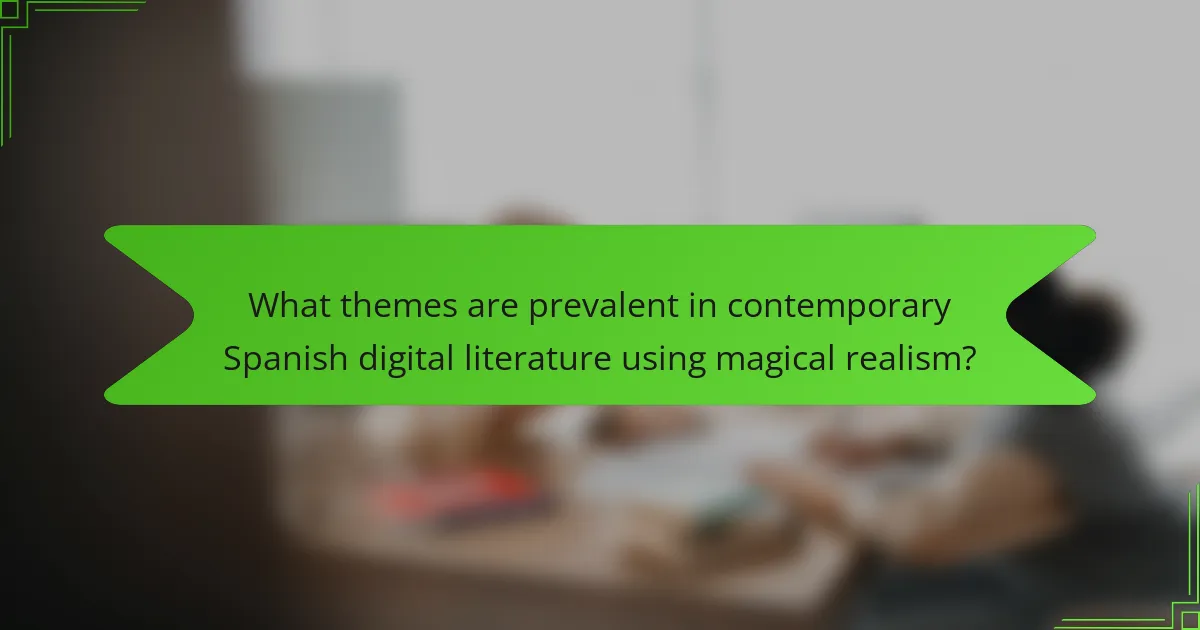
What themes are prevalent in contemporary Spanish digital literature using magical realism?
Magical realism significantly shapes contemporary Spanish digital literature, blending reality with fantastical elements. Themes such as identity, cultural heritage, and social critique emerge prominently. Authors utilize magical realism to explore complex realities, allowing for deeper emotional connections and reflections on societal issues. This narrative technique enhances reader engagement and fosters unique storytelling experiences.
How do these themes reflect cultural identity and social issues?
Magical realism in contemporary Spanish digital literature reflects cultural identity and social issues through its blending of reality and fantasy. This genre captures the complexities of Spanish-speaking societies, addressing themes like historical trauma, identity struggles, and social inequities.
For instance, authors often incorporate local myths and traditions, connecting readers to their cultural heritage. As a result, magical realism serves as a powerful tool for critiquing socio-political realities. The unique attribute of this literature lies in its ability to challenge perceptions of reality, allowing marginalized voices to be heard and understood.
Moreover, the digital format enhances accessibility, enabling broader engagement with these themes. This evolution reflects a rare intersection of technology and tradition, fostering a dynamic discourse on contemporary issues. Through magical realism, authors articulate the nuances of their cultural identities while confronting pressing social challenges.
What role does technology play in shaping these themes?
Technology significantly enhances the expression and accessibility of magical realism in contemporary Spanish digital literature. Digital platforms enable authors to incorporate multimedia elements, blending text with visuals and sounds, thus enriching the narrative experience.
Interactive storytelling allows readers to engage with the text in innovative ways, fostering a deeper emotional connection. For instance, augmented reality can bring magical elements to life, creating immersive experiences that traditional literature cannot achieve.
Additionally, technology facilitates global reach, allowing diverse audiences to access Spanish literary works. This exposure encourages cross-cultural exchanges, further evolving the themes of magical realism within a broader context.
The unique attribute of digital literature lies in its ability to adapt and transform, reflecting contemporary societal issues through a magical lens. As a result, technology plays a crucial role in shaping the themes of magical realism, making them more relevant and resonant today.

Why is audience engagement crucial in contemporary Spanish digital literature?
Audience engagement is vital in contemporary Spanish digital literature because it fosters connection and interaction. Magical realism enhances this engagement by blending reality with fantastical elements, creating immersive experiences. This genre encourages readers to explore deeper themes while participating in narrative discussions. As a result, authors can cultivate loyal communities around their works, driving interest and promoting cultural dialogue. Engaging readers in this way not only enriches their experience but also elevates the significance of the literature itself.
How do interactive elements enhance reader experience?
Interactive elements significantly enhance reader experience by fostering engagement and immersion. In contemporary Spanish digital literature, magical realism often incorporates multimedia features that allow readers to interact with the narrative. This interactivity can include clickable illustrations, audio elements, or animations that enrich storytelling. As a result, readers feel a deeper connection to the characters and themes, enhancing their overall enjoyment and comprehension. Furthermore, these elements can create a unique reading environment, distinguishing works within this genre and attracting a diverse audience.
Which demographic trends are observed in readership?
Demographic trends in readership of contemporary Spanish digital literature show a growing interest among younger audiences. Increased accessibility through digital platforms attracts diverse age groups, particularly millennials and Gen Z. This demographic shift influences themes and narratives, emphasizing social issues and identity. Furthermore, female readers are increasingly engaging with magical realism, reflecting broader cultural conversations.
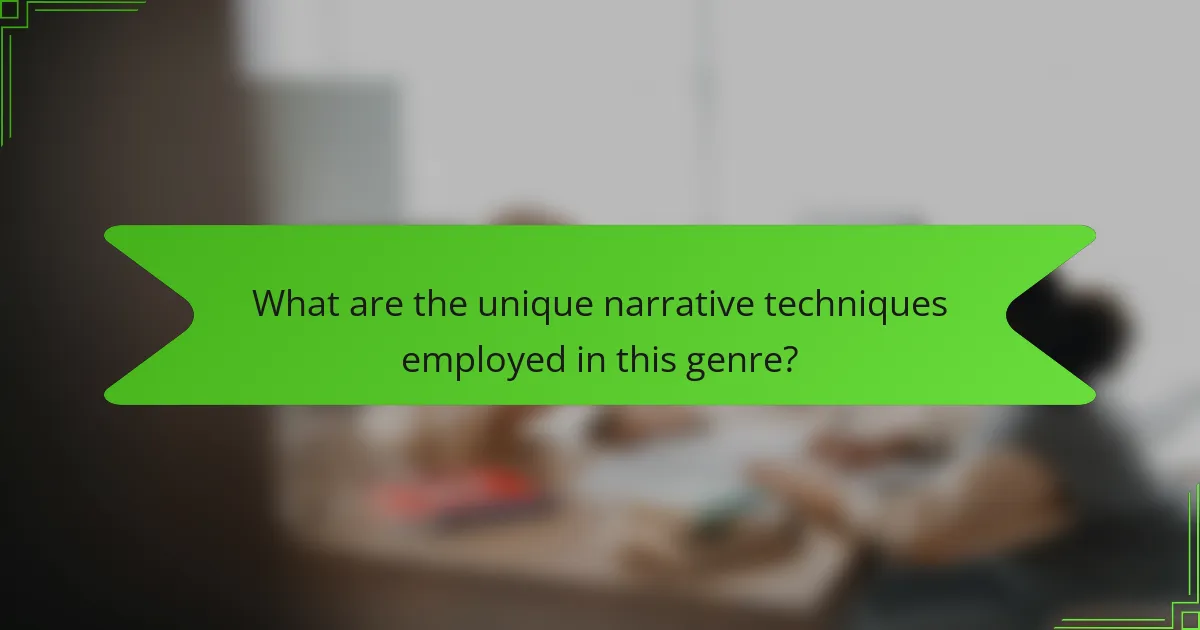
What are the unique narrative techniques employed in this genre?
Magical realism in contemporary Spanish digital literature employs unique narrative techniques that blend the extraordinary with the mundane. These techniques include the seamless integration of magical elements into realistic settings, creating a sense of wonder while maintaining a familiar context.
Authors often utilize fragmented storytelling, where multiple perspectives and non-linear timelines enhance the narrative complexity. This approach allows for deeper exploration of themes such as identity and cultural heritage. Additionally, the use of hypertextual links in digital formats invites readers to engage interactively, creating a layered experience that reflects the fluidity of reality and imagination.
The incorporation of local folklore and myth serves as a unique attribute, enriching narratives with cultural significance. Furthermore, the blending of genres, such as combining poetry with prose, showcases the versatility of magical realism in digital literature. These techniques collectively contribute to a distinctive narrative style that captivates and challenges readers.
How do visual storytelling and multimedia elements contribute to the narrative?
Visual storytelling and multimedia elements enhance narratives by creating immersive experiences. They engage readers emotionally and visually, facilitating deeper connections with themes. In contemporary Spanish digital literature, magical realism thrives through these elements, blending reality with fantastical components. This interplay enriches the narrative, allowing for unique interpretations and emotional resonance. The integration of multimedia can also serve as a rare attribute, distinguishing works and attracting diverse audiences.
What are the challenges faced by authors in blending genres?
Authors blending genres face challenges such as audience expectations, market categorization, and maintaining narrative coherence. These obstacles can complicate the creative process and affect readership engagement. The unique attribute of magical realism in contemporary Spanish digital literature offers a potential solution, allowing authors to navigate these challenges by merging reality with fantastical elements effectively. As a result, authors can expand their storytelling techniques while appealing to diverse audiences.
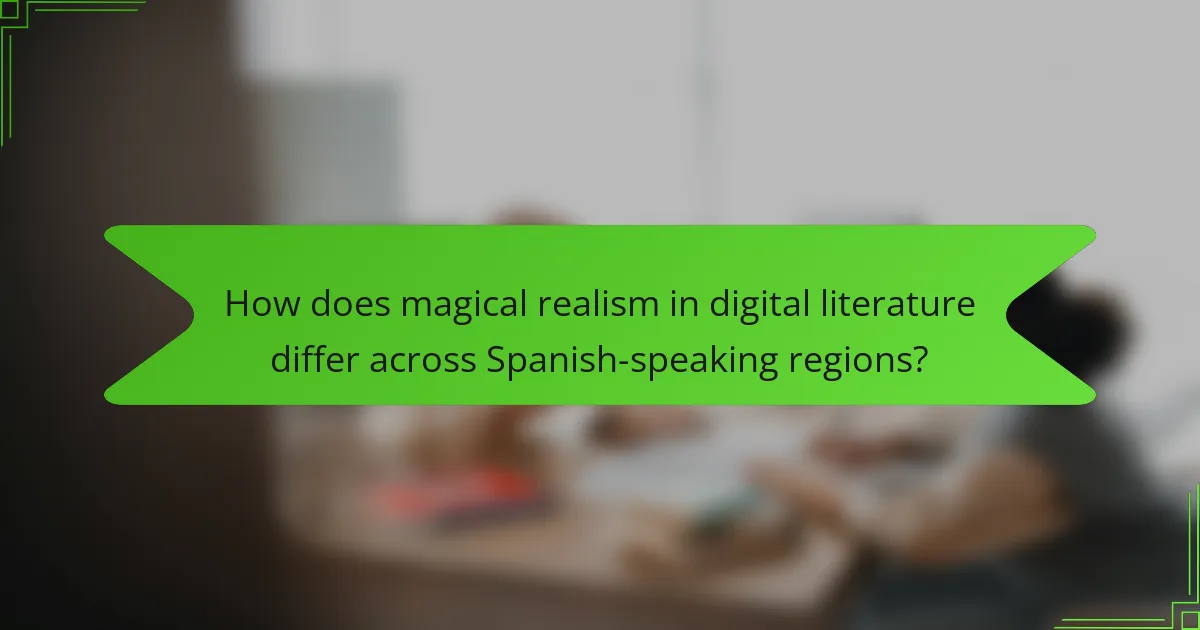
How does magical realism in digital literature differ across Spanish-speaking regions?
Magical realism in digital literature varies significantly across Spanish-speaking regions, influenced by cultural contexts. In Latin America, it often blends folklore with contemporary issues, emphasizing social critique. In contrast, Spain’s approach frequently integrates historical elements, reflecting its unique cultural heritage. This divergence highlights the unique attributes of each region’s literary tradition, enriching the overall landscape of digital literature.
What regional variations in themes and techniques can be identified?
Regional variations in themes and techniques in contemporary Spanish digital literature reveal distinct cultural influences. In Spain, magical realism often merges with local folklore, creating unique narratives. Latin American works emphasize social issues, blending the fantastical with political commentary. The interplay of digital media enhances storytelling, as seen in interactive formats that engage readers differently across regions. Additionally, authors experiment with visual elements, reflecting local artistic traditions and modern technology. This diversity enriches the overall landscape of magical realism in digital literature.
How do cultural influences shape the reception of these works?
Cultural influences significantly shape the reception of magical realism in contemporary Spanish digital literature. These influences reflect historical, social, and political contexts that resonate with readers.
For instance, the legacy of colonialism and the complexities of identity in Latin America inform narrative structures and themes. Readers often connect with elements of magical realism that mirror their own experiences, enhancing engagement.
Moreover, digital platforms allow for diverse interpretations, as cultural backgrounds influence how stories are perceived. The interactive nature of digital literature fosters a communal reading experience, where cultural nuances can be shared and discussed.
As a result, the interplay between culture and magical realism enriches the literary landscape, creating a dynamic space for exploration and understanding.
What are the notable cross-cultural collaborations in this genre?
Notable cross-cultural collaborations in magical realism include works by authors from diverse backgrounds blending their narratives. For instance, Gabriel García Márquez’s influence spans multiple cultures, inspiring writers like Salman Rushdie and Haruki Murakami. Their integration of magical realism showcases unique cultural perspectives while maintaining common thematic elements. Additionally, collaborations in digital literature, such as interactive storytelling platforms, further enhance cross-cultural exchanges, allowing for a fusion of styles and ideas. This genre’s adaptability fosters a rich dialogue among different literary traditions.
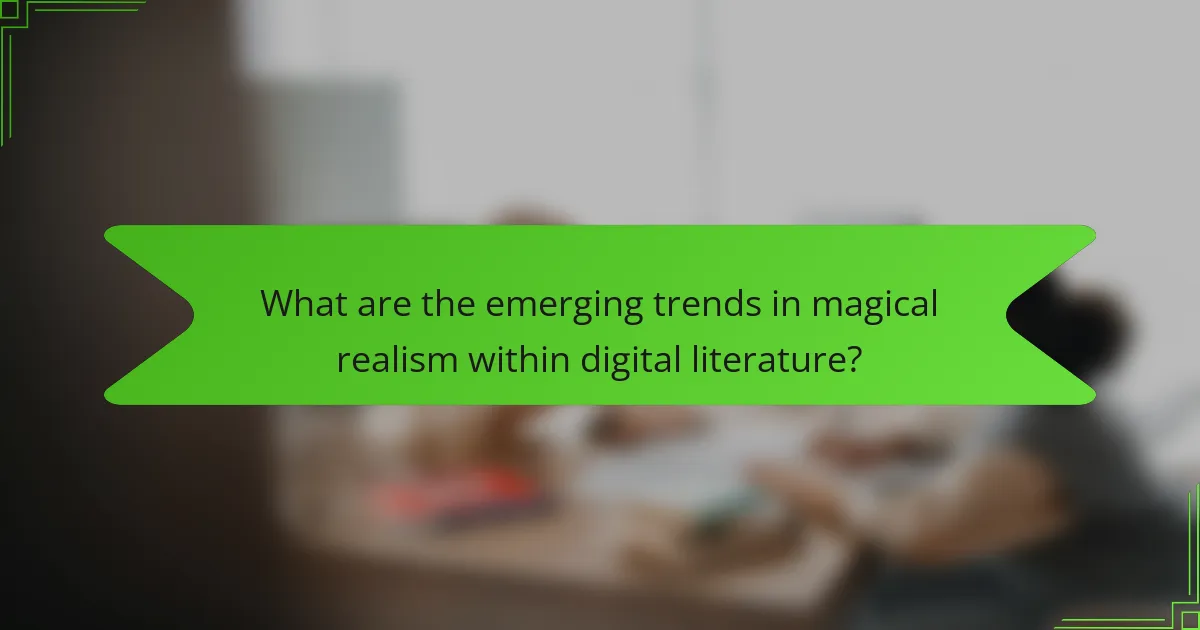
What are the emerging trends in magical realism within digital literature?
Magical realism is increasingly influential in contemporary Spanish digital literature, reflecting cultural complexities. Emerging trends include the integration of interactive narratives, blending traditional storytelling with multimedia elements. Authors are exploring identity and memory through immersive experiences, often leveraging digital platforms for broader accessibility. Unique attributes in this genre include the use of non-linear timelines and fragmented narratives, enhancing reader engagement. As a result, magical realism in digital literature continues to evolve, fostering innovative expressions of reality.
How is the genre evolving with technological advancements?
The genre of magical realism in contemporary Spanish digital literature is evolving through technological advancements by integrating interactive storytelling and multimedia elements. Digital platforms allow authors to weave visual and auditory experiences into narratives, enhancing reader engagement. For instance, augmented reality applications can immerse readers in magical settings, creating a unique interaction with the text. This evolution reflects a unique attribute of digital literature, where traditional storytelling meets innovative technology, offering new ways to explore themes of reality and fantasy. As a result, authors can reach wider audiences and experiment with narrative forms, pushing the boundaries of the genre.
Which new voices are emerging in this literary space?
Emerging voices in contemporary Spanish digital literature often blend traditional storytelling with magical realism. Authors like Mariana Enriquez and Samanta Schweblin are gaining recognition for their unique narratives. Their works reflect cultural themes and social issues, resonating with a global audience. This new wave emphasizes the surreal alongside the everyday, creating a distinctive literary space.
What potential future developments are anticipated in this genre?
Future developments in magical realism within contemporary Spanish digital literature may include increased integration of multimedia elements, such as interactive storytelling and augmented reality. Authors are likely to explore deeper psychological themes, reflecting societal issues through magical frameworks. The rise of digital platforms will facilitate diverse voices, enhancing accessibility and innovation in narrative forms. Additionally, collaborations between writers and visual artists could redefine the boundaries of this genre, creating immersive experiences that blend text and imagery.
What best practices should authors follow when incorporating magical realism in digital literature?
Authors should embrace authenticity, engage with cultural elements, and balance the fantastical with the real when incorporating magical realism in digital literature. These practices enhance narrative depth and resonate with readers. Focusing on character development and emotional truth is essential. Utilizing digital tools for immersive experiences can also enrich storytelling, allowing for interactive elements that reflect the genre’s unique attributes.
